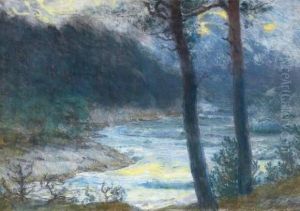Martin Brandenburg Paintings
Martin Brandenburg was a German painter and printmaker associated with the Symbolist movement and Jugendstil, the German variant of Art Nouveau. Born on February 5, 1870, in Berlin, Germany, Brandenburg grew up in an era that was rich in cultural and artistic endeavors. He was initially trained as an architect before he turned to painting, which was his true passion.
Brandenburg's artistic career began in earnest when he moved to Munich, where he studied at the Academy of Fine Arts under the tutelage of influential artists such as Franz von Stuck, who was known for his symbolist paintings and had a profound impact on Brandenburg's artistic direction. Munich was a vibrant artistic hub at the time, and Brandenburg became part of a community of artists who were exploring new aesthetic ideas and forms.
His work is characterized by an intense exploration of mysticism, spirituality, and symbolism. Brandenburg was deeply influenced by the Symbolist movement, which sought to express the more emotional and spiritual aspects of human experience, as opposed to the visible, material world. His paintings often feature mythological and allegorical subjects, rendered with a sense of melancholy and introspective moodiness.
Brandenburg's paintings were marked by their elaborate compositions and rich color palettes. He often employed traditional motifs and forms in innovative ways, integrating them with a decorative style that was typical of Jugendstil. Despite his alignment with these art movements, Brandenburg maintained a distinct personal style that can be seen in his nuanced use of light and shadow, and his ability to convey deep emotion through his subjects.
Tragically, Martin Brandenburg's life was cut short when he died on February 19, 1919, in Berlin, at the age of 49. Although his career was relatively brief, his contributions to German Symbolism and Jugendstil left a lasting impact on the art world. His works continue to be studied and appreciated for their mystical beauty and emotional depth.








